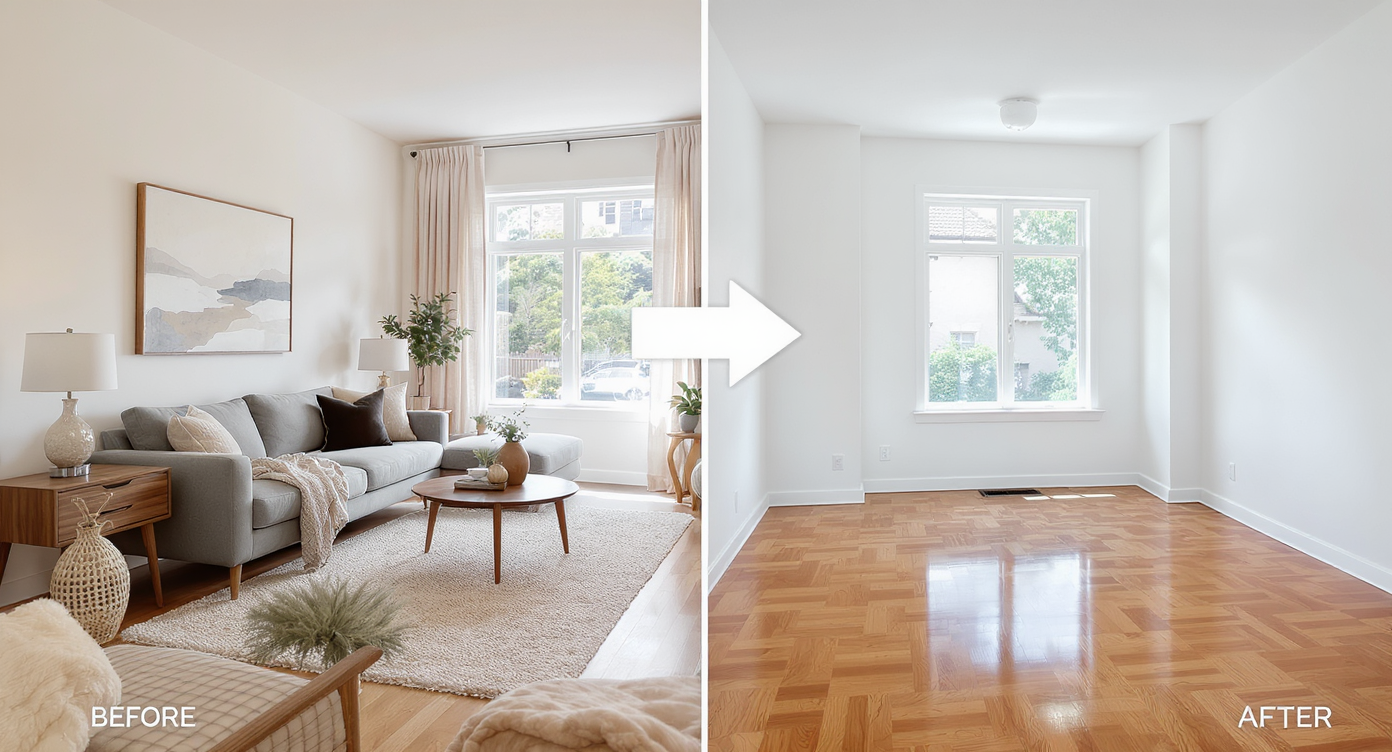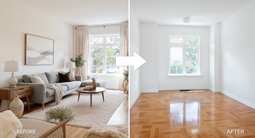TL;DR
Virtual staging for real estate listings can increase online engagement and help buyers visualize — but only when it’s realistic, disclosed, and paired with accurate empty-room photos. In balanced or slow markets, thoughtful staging (virtual or physical) tends to shorten days on market and improve perceived value.
TL;DR

From empty to inviting — see how virtual staging transforms this sunlit bedroom from a blank canvas into a cozy, modern retreat.
SEO intro: Virtual staging can boost listing photos, buyer engagement, and showings — if done transparently and realistically.
TL;DR: If you’re choosing between empty-room photography and virtual staging, your best real estate marketing play is a hybrid: lead with a few virtually staged hero images for context, then show the exact same rooms empty for accuracy. Add captions like “Virtually staged for visualization; room dimensions unchanged.” Agents often report better click-through and more qualified showings when the visuals are honest, clear, and mobile-friendly.
Here’s the thing: vacant listings can feel cold online. Staging — real or virtual — helps buyers visualize scale, traffic flow, and lifestyle. According to national staging surveys, more than 80% of buyer’s agents say staging makes it easier for clients to see a property as a future home, and roughly 1 in 5 say it can nudge offer price up 1%–5%. In softer markets, that context can be the difference between a quick offer and weeks of silence.
But buyers don’t like surprises. Over-edited or misleading virtual staging erodes trust fast. The goal isn’t to create a fantasy — it’s to clarify how the space lives.
What Works Best Right Now
What Works Best Right Now
“Hybrid presentation — both virtually staged and empty photos of the same rooms — tends to earn the most clicks without disappointing buyers.”
The smartest listing strategies blend marketing and transparency. Use 3–6 virtually staged images to demonstrate layout, then pair each with the untouched photo in the carousel. This approach captures attention while protecting credibility. Agents often advise labeling each image and noting the disclosure in remarks. When done well, you’ll see two wins: more online engagement and fewer let-downs at the showing.
- Lead with purpose-built hero images. Feature the living room, the primary suite, and one dining or flex space. Listings with clear “anchor rooms” tend to see higher click-through and longer time-on-page.
- Stage to the buyer profile. Price point and neighborhood matter. Market analysts suggest modern, neutral palettes for urban condos; warm transitional for suburban single-family; scale furniture to emphasize livable zones.
- Respect the floor plan. Keep pathways at 36 inches, show door swings, and position seating in realistic groupings. Buyers today expect accurate representation; mis-sizing furniture can backfire immediately.
- Caption and alt text. Add a caption like “Virtually staged; finishes unchanged” and alt text such as “Virtually staged living room showing scale for a 7-foot sofa.” Accessibility boosts UX and SEO for listing visuals.
In many markets, agents report staged listings getting 20%–40% more online saves and faster tour requests compared with the same property shown vacant, especially in the first 7–10 days on market.
Anecdote
A midtown agent listed a vacant loft during a slow spring. Empty photos weren’t converting. They added three virtually staged images — a living vignette, a workspace, and a dining zone — each paired with the original. Showings doubled the next week and an offer arrived at 98% of list. The buyer said, “I couldn’t see where the dining table would go until your photos showed it.”
Common Mistakes & Misconceptions
Common Mistakes & Misconceptions
“If the photos promise what the property can’t deliver, you’ll pay for it in buyer trust and days on market.”
- Not disclosing virtual staging. Some MLSs require disclosure. Even when not required, label images and public remarks. Transparency reduces fallout and protects your client relationship.
- Changing fixed finishes. Swapping cabinets, flooring, or countertops in photos is misleading. Experts recommend keeping listing photos realistic enough that buyers recognize the property on arrival.
- Furniture that’s the wrong scale. Oversized sectionals in small rooms or floating rugs ruin credibility. Use common dimensions: 84-inch sofa, 5x8 rug in small living rooms, queen beds in secondary bedrooms.
- Over-brightening and window swaps. Blown-out windows and fake views trigger skepticism. Keep lighting within realistic dynamic range and retain true exterior sightlines.
- One-size-fits-all style. Luxury buyers notice generic catalogs. Tailor materials and styling to local comps and price tier; minor misalignment can cost perceived value.
Pro Tips Agents Swear By
Pro Tips Agents Swear By
“Stage for mobile first; 70%–80% of listing views happen on phones.”
- Mobile-first composition. Tight, vertical-friendly crops with a clear focal point outperform wide, low-contrast shots on phones.
- Show the empty and the staged back-to-back. Buyers appreciate context. It also reduces questions about room size and layout consistency.
- Use vignette staging in key spaces. A bottle-and-glasses setup on a kitchen counter, fresh towels and greenery in the bath, and a styled entry table lift perceived care at a low cost.
- Verify dimensions. Photographers recommend using a 24–35mm equivalent focal length for interiors and placing standard-size furniture to avoid distortion.
- Add a simple floor plan. Even a basic plan can increase tour bookings; buyers want to confirm flow. Pair it with staged visuals for the one-two punch.
- Alt text and captions that sell. Try: “Virtually staged dining room seats six comfortably; room dimensions 12x14.” It’s descriptive, honest, and keyword-rich.
Real Stories, Real Results
Real Stories, Real Results
“When staging clarifies function, buyers move faster — and with more confidence.”
The condo with a confusing living-dining combo. An agent listed a 900-square-foot city condo with a tricky open plan. Empty photos underperformed. After adding three virtually staged images (plus the original empties), clicks jumped week-over-week and the home went under contract in 9 days versus the building’s 21-day median. The buyer mentioned the dining table placement solved their biggest hesitation.
The suburban spec home that felt cold online. A builder tried empty-room photos first. Showings were light. They relaunched with virtual staging and a printable floor plan. Tour volume improved and the accepted offer came in at full price after a small price tweak — the visuals framed the value.
The misstep that killed momentum. A seller approved virtually staged kitchen photos that “updated” the cabinets. Buyers arrived to honey oak. Fallout was immediate; feedback used the word “misleading.” The listing sat until the team swapped in honest photos and noted the potential for a cosmetic refresh. Offers followed once trust was restored.
Visualization Scenario
Picture a buyer scrolling on a commuter train. The first image is a bright, virtually staged living room that naturally seats four, with a clear walkway to the balcony. Swipe — the same room, empty, proves the windows, floors, and dimensions are real. A caption confirms: “Virtually staged; finishes unchanged.” Trust established, the buyer saves the listing and books a tour.
FAQ: People Also Ask
FAQ: People Also Ask
How much does virtual staging cost for real estate listings?
Most virtual staging costs $25–$100 per photo, with premium, rush, or custom design sets running $150+ per image. For larger properties, agents often budget $200–$600 to cover the key rooms that drive buyer interest.
Is virtual staging worth it for agents in a slow market?
Yes — in slower markets, virtual staging can shorten days on market by improving listing photos and showings, especially when paired with empty-room photos and a floor plan. The small spend can yield a 1%–5% perceived value lift, according to agent surveys.
Can buyers tell if photos are virtually staged?
Often. Buyers notice mis-scaled furniture, changed finishes, and over-bright edits. Disclose virtual staging in photo captions and remarks, and always include the untouched photos of the same rooms.
What’s better for ROI: real home staging or virtual staging?
Physical home staging delivers the strongest in-person impact and can command top-of-market results, but it’s costlier. Virtual staging is a budget-friendly way to elevate property photos online; a hybrid approach covers both marketing and accuracy.
How should I market a vacant home online without overpromising?
Use a hybrid listing strategy: 3–6 virtually staged hero images plus the original empty photos, clear disclosures, mobile-first crops, and a simple floor plan. This balances real estate marketing goals with buyer trust.
Tags:
- virtual staging
- home staging tips
- real estate marketing strategies
- property photos and listing visuals
- how to market vacant homes
- virtual staging for real estate agents
- best listing strategies online
Ready to present your next vacant listing with clarity and impact? Try ReimagineHome to create realistic, on-brand virtual staging that’s disclosure-friendly and buyer-approved.
The Takeaway
The Takeaway
“Use virtual staging to clarify, not to conceal.”
Let’s be real: real staging remains the gold standard for in-person impact. But when budgets or timelines rule it out, virtual staging — paired with accurate empty photos and clear disclosure — is the next best way to market a vacant home. The goal is simple: help buyers visualize how they’ll live there, without rewriting reality. Think like a storyteller. Lead with the rooms that sell the lifestyle, keep the details honest, and make every click feel like the start of a tour.
Tools to explore: ReimagineHome for AI-powered room styling and virtual staging at scale, BoxBrownie for editing support, Matterport for tours, and Canva for clean, branded marketing sheets. Use them to elevate clarity — not to create a fiction.
.svg)

.svg)





.png)